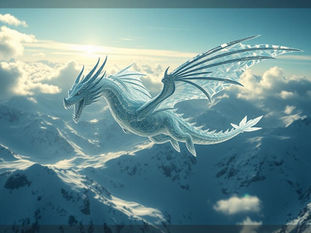
How to Make Characters Look the Same in Midjourney Illustrations
May 1
4 min read
0
2
0

Creating a storybook, comic, or series often requires using the same characters in different scenes and situations. Making sure your AI-generated characters stay consistent frame after frame can be tricky. This post shares simple ways to achieve character consistency using tools like Midjourney and ChatGPT, along with tips for adding the final polish in programs like Photoshop or Canva.
Planning Your Creative Process
A good plan helps keep everything organized. When creating a children's book, for example, you might use these steps:
Develop the story and characters using a language tool like ChatGPT.
Generate character images and scenes using an AI image tool like Midjourney.
Refine and combine images and text using editing software like Photoshop and Canva.
Let's look at each part.
Using AI for Story and Rhymes
Tools like ChatGPT are great for brainstorming and writing simple text, like rhymes for a children's book. You can tell the AI what your book is about:
"I'm writing a book about a little girl and her dog exploring animals. They find a new animal on every page."
Then, you can ask the AI to write short rhymes for specific animals. You can provide a list of animals, and it can generate text that fits the theme and age group you need. For example:
"Now I will write the animals depicted one by one for every page and I want you to write a short four sentence rhyme about that animal. The rhyme should be intended for children..."
This gives you the text content for your book quickly.
Creating Your Character Generations with Midjourney
Midjourney is key to making the pictures. You start by describing the character you want. For a girl character, a prompt might be:
"a girl with short curly hair different angles in the style of children book character character sheet white background"
Adding descriptive words like "cute" or being specific about appearance helps Midjourney understand what you want. Keywords like "character sheet" or "different angles" also guide the AI to give you variations of the character.
Aspect Ratios for Character Sheets
Choosing the right image size matters. A 3:2 aspect ratio is common. However, a trick using a 3:16 aspect ratio can make a long sheet with many character examples at once, showing various angles and poses.
[H3]Keeping Your Characters Consistent[/H2]
This is a vital part. Here are two main methods:
Method 1: Use Image References
Start by generating an image you like. Crop the character from it (using a tool like Photoshop, Canva, or even Paint). Then, upload the cropped image into your prompt along with the original text prompt used to create it. This tells Midjourney to use the uploaded image as a guide for the new generations.
Method 2: Use Seeds
Every image generated in Midjourney has a unique seed number. If you generate an image you like, find its seed number (you can react to the image in Discord to reveal it). You can use this number in your next prompt by adding `--seed [number]`. Using the same seed number with the same prompt makes Midjourney create a very similar image.
[H3]The Best Way: Combine Both Methods[/H2]
Using both image references and the seed from a preferred image gives you the best chance for consistent results. You can even make small changes to the prompt, like describing different clothing, and often keep the main character's look consistent while changing their outfit or context.
Need to speed up your Midjourney workflow and manage multiple image generations for character consistency? The Midjourney Automation Suite from TitanXT can help you automate prompts and manage seeds more efficiently.
Midjourney Versions
Midjourney has different versions. Version 5 tends to create more realistic images, while version 4 might be preferred for a more illustrated or 'digital art' look. Experimenting with both can give you different styles depending on what your project needs.
Generating Animals and Backgrounds
Once your main characters are set, you can generate images for the other elements, like animals and backgrounds, using a similar approach. Use prompts that describe the animal (e.g., "beautiful Corgi") and include keywords like "different angles," "children book character style," and "white background." You can even try using the same seed number used for your characters to help keep the overall style similar across different elements.
For backgrounds, describe the scene (e.g., "African desert and nature with a small water pond in the middle") and be sure to add "in the style of children book illustration" to match the look of your characters and animals.
Putting It All Together in Photoshop or Canva
AI tools give you the pieces; editing software helps you assemble them into finished scenes. Photoshop or Canva let you:
Combine characters, animals, and backgrounds.
Add shadows to characters to make them feel part of the scene and add depth.
Place characters behind objects to create a sense of space.
Edit parts of an image, like erasing a hand to make it look like a character is holding something.
Adapt characters to the environment, like using a gradient to make legs look wet when a character is in water.
These simple tricks can greatly improve how your final images look and make the scenes feel more realistic and connected.
For managing many character images and backgrounds as you create complex scenes, automating parts of your Midjourney process can save significant time. Check out the Midjourney Automation Suite from TitanXT to streamline your workflow.
Laying Out Your Book
Software like Canva is great for arranging your images and text. You can set up pages with an illustration on one side and the corresponding rhyme on the other, making it easy to read. Make sure to design a title page and cover that grab attention. Use different fonts and maybe hints of the illustrations inside. A simple ending page is good too.
Making consistent characters with AI is a mix of good prompting, using reference images, and leveraging seed numbers. With a bit of editing work, you can bring your illustrated stories to life.
Want to spend less time manually generating character variations and more time on the creative parts? Discover how the TitanXT Midjourney Automation Suite can help automate your character generation and scene building processes.






